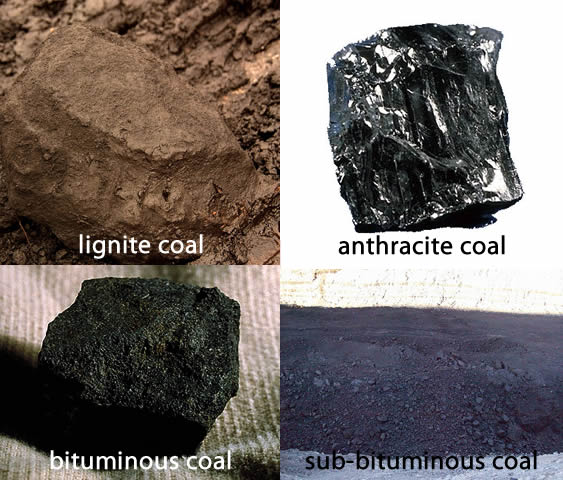Types of Coal
There are four basic varieties of coal: lignite, sub-bituminous, bituminous, and anthracite. All are formed from ancient plant material. Variations are the result of different geologic forces which affect the carbon content and heating value--also the dollar value!
- Lignite: Sometimes called "brown coal," this is a brownish-black coal with generally high moisture and ash content and lower heating value. It is the lowest ranked coal. It contains 25 to 35 percent carbon and has the lowest heating value, 4,000 to 8,300 Btus per pound.
- Sub-bituminous: A dull black coal, it contains about 35 to 45 percent carbon and has a heating value of 8,300 to 11,500 Btus per pound. It is used primarily for generating electricity and for space heating.
- Bituminous: Sometimes called "soft coal," this coal is 45 to 86 percent carbon, softer than anthracite, and has a heat content between 10,500 and 14,000 Btus per pound.
- Anthracite: Sometimes called "hard coal," this coal is 86 to 97 percent carbon and has the highest energy content of all coals, nearly 15,000 Btus per pound.

How does the World Use Coal?
To Read Now
Visit the World Energy Council and see the publication "World Energy Resources 2016." You can download your own copy, or access the copy under the Lesson 6 tab. The information in this publication is not the most current, but it collects some interesting data in one place that will give you an idea for how coal is (still) used globally as a major energy source.
Please read the following in the Introduction:
- For an explanation of how the Paris Agreement is likely to impact world energy markets, read the "THE ROLE OF THE PARIS AGREEMENT ON SHAPING ENERGY DEVELOPMENTS" section, pp. 10 - 11 (This is pp. 12 - 13 on the navigation bar at the top.)
- For an overview of the growth of the coal industry through the mid-2010s, read the Summary, pp. 12 - 13 (pp. 14 - 15 on the navigation bar)
In the main body of the report (this portion starts after the Introduction, which ends on p. 49) read:
- Generation Technologies, pp. 11 - 14 (pp. 53 - 56 on the navigation bar at the top)
- Socio-economics, pp. 34 - 36 (pp. 76 - 78 on the navigation bar)
As you read this, it will help to remember the international definition used by the United Nations for proved recoverable reserves: "the quantity within the proved amount in place that can be recovered in the future under present and expected local economic conditions with existing available technology" (World Energy Council).
To Read Now
- Read through the "coal" section of the Energy Information Administration's (EIA's) International Energy Outlook 2021. This is the most recent full "IEO" report available. The material on global coal use is on pages 26-28.
Note: reference cases are forward-looking scenarios (through 2050 and 2040, respectively), which does not incorporate prospective legislation or policies that might affect energy markets, including prospective greenhouse gas reduction policies.
To Read Now
The global energy market is a dynamic place. This is but one reason that it is exciting to be in the energy field (hopefully I'm not the only one who realizes this!). Read the following to get an understanding for recent trends in the global coal market.
- "A tale of three countries: how Czechia, Germany, and Poland plan to ditch coal" Euractive, May 2021.
- "Germany Flirts With Power Crunch in Nuclear and Coal Exit" Bloomberg Green, August 2021 (here is a .pdf in case there is a paywall)
- Read through the Coal section of the 2022 BP Statistical Review of World Energy.
- Finally, for insight into various market and nonmarket forces impacting the price of coal, read "As Investors and Insurers Back Away, the Economics of Coal Turn Toxic" at Yale Environment 360, March 2020.
The EIA and BP publish excellent (and free!) information, loaded with analysis and details far beyond the breadth and depth of this lesson. I encourage you to please keep these important publications and organizations (the International Energy Agency and Yale Environment 360 are great as well) in mind, however, as they may be helpful to you in other courses, research, and your professional life--now and in the future!
